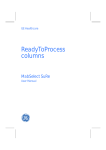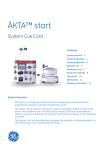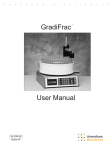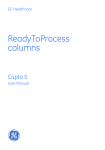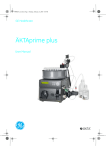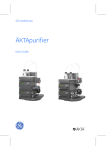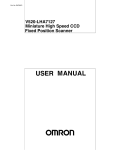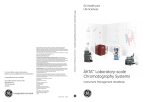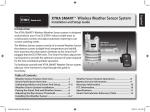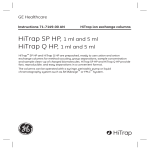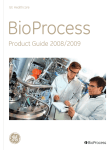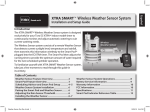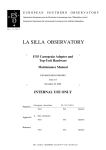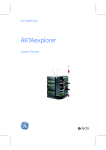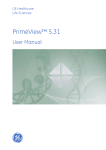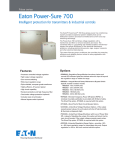Download ÄKTAprime plus - GE Healthcare Life Sciences
Transcript
GE Healthcare ÄKTAprime plus Cue Cards Contents System Preparation 2 Buffer exchange on HiTrap Desalting 4 Buffer exchange on HiPrep 26/10 Desalting 6 Histidine-tagged protein purification, step elution 8 Histidine-tagged protein purification, gradient elution 10 IMAC purification - any metal 12 On-column refolding 14 GST-tagged protein purification 16 Strep(II)-tagged protein purification 18 MBP-tagged protein purification 20 MAb purification, step elution 22 MAb purification, gradient elution 24 IgM purification 26 Albumin removal 28 Removal of trypsin-like serine proteases 30 Anion exchange 32 Cation exchange 34 Method Templates value table 36 System Preparation 1 Starting the system a) Press the button on the back of the system. Note: Wait at least 15 minutes before using the system after the lamp has been turned on to avoid drifting UV base line. b) Wait until the system self-test has been completed (30-40 seconds). Templates is displayed when the system is ready to use. c) If using pH: Calibrate the pH. The pH must be calibrated every day. See ÄKTAprime plus User Manual for instructions. 2 Starting the computer 5 Checking the flow rate a) Start the computer. a) Set the injection valve to position WASTE. b) Start PrimeView™. b) Start the flow (1-50 ml/min). c) Check the communication between system and computer. c) Use a graduated glass cylinder to collect at the WASTE outlet (port 5). Collect during at least one minute. Tip! If communication has been established, the text Controlled By: prime should be displayed at the lower right corner of the screen. If not, check the connections. 3 Purging the system flow path a) If the flow path is filled with storage solution (e.g. ethanol 20%), remove it as follows: • Place the three brown waste tubings in waste. • Set all inlet tubings (B, A1, …) that will be used in water (see the appropriate cue card). • Select the application template System Wash Method, select the inlets to be washed. Press OK. Templates Select Buffer V. Pos B,A:_,_,_,_,_,_,_,_ OK Note: Inaccurate flow rate may be due to air in the pump. If this is the case, flush the pump with buffer and try again. If the problem persists, flush the system with ehtanol or methanol followed by water. 6 Preparing the fraction collector a) Check that the delay volume is correct. The delay volume is equal to the volume between the UV flow cell and the fraction collector (default 380 µl). Set Parameters Set Delay UV to Frac (x µl) Setup and Calibration Lock knob Application Template b) Fill the fraction collector with tubes*. System Wash Method b) If there are large amounts of air in the tubing: Fill the tubing using Purge kit P-950. See ÄKTAprime™ plus User Manual for detailed instructions. 4 Preparing the monitors a) Check the UV lamp filter position and the lamp position. b) Check that the UV lamp is on. Set Parameters 5 mm c) Adjust the height of the delivery arm so that the horizontal mark on the tube sensor is at the same level as the top of the collection tubes. d) Check that the sensor is in the correct position for the tube size. The eluent tubing should be positioned above the center of the collection tube. Use the red sensor control to position the tube holder. Sensor Control Lamp (on) 11-0027-48 AC, 2007-09 • p2 * See each cue card for information on the number of tubes to be used. e) Place the tubing holder over the length guide (small hole) in the delivery arm, push the tubing down to the bottom of the guide and tighten the nut. This ensures that the correct length of the tubing is exposed. Note: Make sure that the end of the tubing is cut leaving a straight edge. For more information, see ÄKTAprime plus User Manual . c) Connect the column between port 1 on the injection valve (7-port valve) and the UV flow cell. 1/16" Male 1/16" Male HiTrapTM Tubing holder UV monitor HiPrepTM f) Re-install the tubing holder into the delivery arm. 1/16" Male g) Rotate the rack by hand until the rear half of the tube sensor rests against tube 1. 8 Filling the buffer inlet tubing h) Press feed tube on the front panel. The bowl moves to the correct position to collect the first fraction in tube 1. i) Make sure that drop synchronization is activated. Set Parameters Set Drop Sync Active (yes) Note: Drop synchronization can only be used at flow rates ≤ 3 ml/min. 7 Cleaning the sample loop and connecting the column a) Mount a sample loop between port 2 and port 6 that is large enough to hold your sample. b) Clean the loop and the injector fill port: Inject (with a syringe) 5 times the loop volume of water or binding buffer through the injection fill port. Prepare the buffers. Make sure that correct inlet tubing is put into correct buffer. • If using an application template: It is not necessary to perform the wash procedure because this is included in the method. • If using a method template: Pre-fill all inlet tubings with buffer. Select the application template System Wash Method, select the inlets to be washed and press OK. The system is now prepared. Start the method. 9 Storage of the system a) Clean the loop and the injector fill port: • Inject (with a syringe) 5 times the loop volume of water through the injection fill port. • Repeat this step with 20% ethanol. b) Flush the system flow paths: • Put all used inlet tubings in water. • Select the application template System Wash Method, select the inlets to be washed and press OK. • For long-term storage of the system, repeat step b) with 20% ethanol. c) Shut down the system. 11-0027-48 AC, 2007-09 • p3 Buffer exchange on HiTrap Desalting 1 Preparing the buffers • • Use high purity water and chemicals. Filter all buffers through a 0.45 µm filter before use. Buffer (port A1): 20 mM sodium phosphate, 0.15 M NaCl, pH 7.0* c) Enter the sample volume and press OK to start the template. Theoretical gradient in Desalting HiTrap Desalting Application Template. %B 100 Prepare at least 500 ml eluent. * When performing buffer exchange use the appropriate buffer. Priming & Equilibration 2 Preparing the sample 50 Elution Pass the sample through a 0.45 µm filter. Sample The maximum recommended sample volume is 1.5 ml. 3 Preparing the system 6 a) Place the inlet tubing from port A1 (8-port valve) and port B (2-port valve) in the buffer. b) Place the three brown waste tubings in waste. c) Connect the column between port 1 on the injection valve (7-port valve) and the UV flow cell (see Ordering information on next page for suitable columns). AU280nm d) Fill the fraction collector rack with 18 mm tubes (minimum 20) and position the white plate on the fractionation arm against the first tube. e) Connect a sample loop large enough for your sample between port 2 and 6 on the injection valve. Use a syringe to manually fill the loop. 0.10 4 Selecting Application Template and starting the method a) Check the communication to PrimeView. At the lower right corner of the screen the text Controlled By: prime should be displayed. b) Use the arrow and OK buttons to move in the menu tree until you find Desalting HiTrap Desalting. Templates Application Template Desalting HiTrap Desalting 11-0027-48 AC, 2007-08 2007-09 • p4 Set Sample Inj. Vol (00.0 ml) 00.0 Run Application Template Press OK to start Run data displayed Min 5 Typical result 0.15 Note: If the same sample is applied repeatedly, a Superloop™ can be used. For information of how to use it see the instructions for the Superloop. 3 Total separation time = 9 min + sample application time –– UV 280 nm –– Conductivity Sample: Histidine-tagged protein in 20 mM sodium phosphate, 0.5 M sodium chloride, 0.5 M imidazole, pH 7.4 Column: HiTrap Desalting 5 ml Buffer (A1): 20 mM sodium phosphate, 0.15 M sodium chloride, pH 7.0 Histidine-tagged protein 0.05 Inject 0 0 1 min Troubleshooting Ordering information High backpressure: Product Quantity Code No. • Column clogged – Clean the column according to instructions. Make sure the sample has been centrifuged and/or filtered through a 0.45 µm filter. HiTrap Desalting 5 × 5 ml 100 × 5 ml* 17-1408-01 11-0003-29 Superloop 10 ml 1 18-1113-83 • System clogged – Replace the column with a piece of tubing. Check pressure. If backpressure > 0.3 MPa, clean system according to manual. * Pack size available by special order Eluted sample still contaminated: • Check that the sample load limit is not exceeded. 11-0027-48 AC, 2007-09 • p5 Buffer exchange on HiPrep 26/10 Desalting 1 Preparing the buffers • • Use high purity water and chemicals. Filter all buffers through a 0.45 µm filter before use. Buffer (port A1): 20 mM sodium phosphate, 0.15 M NaCl, pH 7.0* c) Enter the sample volume and press OK to start the template. Theoretical gradient in Desalting HiPrep Desalting Application Template. %B 100 Prepare at least 500 ml eluent. * When performing buffer exchange use the appropriate buffer. 2 Preparing the sample Priming & Equilibration 50 Elution Pass the sample through a 0.45 µm filter. Sample The maximum recommended sample volume is 15 ml. 3 Preparing the system 13 a) Place the inlet tubing from port A1 (8-port valve) and port B (2-port valve) in the buffer. b) Place the three brown waste tubings in waste. c) Connect the column between port 1 on the injection valve (7-port valve) and the UV flow cell (see Ordering information on next page for suitable columns). d) Fill the fraction collector rack with 18 mm tubes (minimum 25) and position the white plate on the fractionation arm against the first tube. e) Connect a sample loop large enough for your sample between port 2 and 6 on the injection valve. Use a syringe to manually fill the loop. Note: If a Superloop is needed, additional information is supplied in the instructions for Superloop. 4 Selecting Application Template and starting the method b) Use the arrow and OK buttons to move in the menu tree until you find Desalting HiPrep Desalting. Application Template Desalting HiPrep Desalting 11-0027-48 AC, 2007-09 • p6 5 Typical result Sample: BSA and sodium chloride Column: HiPrep 26/10 Desalting, 53 ml Buffer (A1): 20 mM sodium phosphate, 0.15 M NaCl, pH 7.0 AU280nm 0.5 BSA 0.4 0.3 0.2 –– UV 280 nm –– Conductivity 0.1 Inject a) Check the communication to PrimeView. At the lower right corner of the screen the text Controlled By: prime should be displayed. Templates 5 Total separation time = 18 min + sample application time Set Sample Inj. Vol (00.0 ml) 00.0 Run Application Template Press OK to start Run data displayed 0 0 1 2 3 min Min Troubleshooting Ordering information High backpressure: Product Quantity Code No. • Column clogged – Clean the column according to instructions. Make sure the sample has been centrifuged and/or filtered through a 0.45 µm filter. • System clogged – Replace the column with a piece of tubing. Check pressure. If backpressure > 0.3 MPa, clean system according to manual. HiPrep 26/10 Desalting 1 (53 ml) 17-5087-01 4 (53 ml) 17-5087-02 Superloop 10 ml 1 18-1113-83 Superloop 50 ml 1 18-1113-84 Eluted sample still contaminated: • Check that the sample load limit is not exceeded. 11-0027-48 AC, 2007-09 • p7 Histidine-tagged protein purification, step elution 1 Preparing the buffers • • Use high purity water and chemicals. Filter all buffers through a 0.45 µm filter before use. Binding buffer (port A1): 20 mM sodium phosphate, 0.5 M NaCl, 20 mM imidazole, pH 7.4 * Elution buffer (port B): 20 mM sodium phosphate, 0.5 M NaCl, 0.5 M imidazole, pH 7.4 Prepare at least 500 ml of each eluent. * Alternative binding buffers: 5–40 mM imidazole can be included in the binding buffer to reduce unspecific binding of non-histidine-tagged proteins. The concentration of imidazole is protein dependent and if the protein of interest elutes or does not bind at a certain imidazole concentration, then reduce the concentration. e) Connect a sample loop large enough for your sample between port 2 and 6 on the injection valve. Use a syringe to manually fill the loop. Note: If a Superloop is needed, additional information is supplied in the instructions for Superloop. 4 Selecting Application Template and starting the method a) Check the communication to PrimeView. At the lower right corner of the screen the text Controlled By: prime should be displayed. b) Use the arrow and OK buttons to move in the menu tree until you find Affinity Purification any HiTrap. 2 Preparing the sample a) Adjust the sample to composition of binding buffer by: • diluting the sample in binding buffer or • by buffer exchange using HiTrap Desalting or HiPrep 26/10 Desalting. b) Pass the sample through a 0.45 µm filter. Application Template a) Place the inlet tubing from port A1 (8-port valve) in the binding buffer and the tubing from port B (2-port valve) in the elution buffer. Note: If a 5 ml column is preferred, see cue card on p.36. Theoretical gradient in Affinity Purification any HiTrap Application Template. %B Elution 100 Priming Equilibration 50 d) Fill the fraction collector rack with 18 mm tubes** and position the white plate on the fractionation arm against the first tube. ** The number of tubes to insert in the fraction collector varies with the sample volume. Fill the fraction collector with 20 tubes + one tube/ml sample. For example, if the sample volume is 10 ml, fill the fraction collector with 20 + 10 = 30 tubes. However, note that the maximum capacity of the fraction collector is 95 tubes, limiting the sample volume to 75 ml. 11-0027-48 AC, 2007-09 • p8 Run data displayed c) Enter the sample volume and press OK to start the template. b) Place the three brown waste tubings in waste. c) Connect the column between port 1 on the injection valve (7-port valve) and the UV flow cell (see Ordering information on next page for suitable columns). Run Application Template Press OK to start Affinity Purification any HiTrap Note: If HisTrap FF crude column is used no filtration nor clarification of the sample is needed. 3 Preparing the system Set Sample Inj. Vol (00.0 ml) 00.0 Templates Water wash & priming Sample 1 10 Re-equilibration 20 10 Total separation time = 47 min + sample application time 5 Min 5 Typical result Ordering information Sample: Clarified homogenate of E. coli expressing histidine-tagged protein Column: HisTrap™ HP 1 ml Binding buffer (port A1): 20 mM phosphate, 0.5 M NaCl, 20 mM imidazole, pH 7.4 Elution buffer (port B): 20 mM phosphate, 0.5 M NaCl, 0.5 M imidazole, pH 7.4 AU280 nm %B 100 UV 280 nm Programmed %B 2.5 80 2.0 60 1.5 40 1.0 20 0.5 0 0 5 10 15 20 25 30 35 Product Quantity HisTrap HP 5 × 1 ml Code No. 17-5247-01 100 × 1 ml* 17-5247-05 HisTrap FF 5 × 1 ml 17-5319-01 100 × 1 ml* 17-5319-02 HisTrap FF crude 5 × 1 ml 11-0004-58 100 × 1 ml* 11-0004-59 HiTrap Desalting 5 × 5 ml 17-1408-01 100 × 5 ml* 11-0003-29 HiPrep 26/10 Desalting 1 (53 ml) 17-5087-01 4 (53 ml) 17-5087-02 Superloop 10 ml 1 18-1113-83 Superloop 50 ml 1 18-1113-84 Superloop 150 ml 1 18-1023-85 * Pack size available by special order min Troubleshooting High backpressure: • Column clogged – Clean the column according to instructions. Make sure the sample has been centrifuged and/or filtered through a 0.45 µm filter. For unclarified samples using HisTrap FF crude, make sure the sample has been lysed properly, e.g. using thorough sonication and DNase treatment. • System clogged – Replace the column with a piece of tubing. Check pressure. If backpressure > 0.3 MPa, clean system according to manual. No binding: • • Check that the correct column is used. Check that the inlet tubing from each buffer is connected to the correct inlet port. • Check that the composition and pH of the buffers are correct. • Check that the sample has been adjusted to binding buffer conditions. • Check that your sample contains target protein. No elution: • Check that the inlet tubing from each buffer is connected to the correct inlet port. • Check that the composition and pH of the buffers are correct. • Use alternative elution conditions according to the column instructions. • Check that your sample contains target protein. 11-0027-48 AC, 2007-09 • p9 Histidine-tagged protein purification, gradient elution 1 Preparing the buffers • • Use high purity water and chemicals. Filter all buffers through a 0.45 µm filter before use. Binding buffer (port A1): 20 mM sodium phosphate, 0.5 M NaCl, 20 mM imidazole, pH 7.4 * Elution buffer (port B): 20 mM sodium phosphate, 0.5 M NaCl, 0.5 M imidazole, pH 7.4 4 Selecting Application Template and starting the method a) Check the communication to PrimeView. At the lower right corner of the screen the text Controlled By: prime should be displayed. b) Use the arrow and OK buttons to move in the menu tree until you find His Tag Purification HisTrap. Prepare at least 500 ml of each eluent. * Alternative binding buffers: 5–40 mM imidazole can be included in the binding buffer to reduce unspecific binding of non-histidine-tagged proteins. The concentration of imidazole is protein dependent and if the protein of interest elutes or does not bind at a certain imidazole concentration, then reduce the concentration Set Sample Inj. Vol (00.0 ml) 00.0 Templates Application Template Run Application Template Press OK to start His Tag Purification HisTrap Run data displayed c) Enter the sample volume and press OK to start the template. Note: If a 5 ml column is preferred see cue card on p.36. 2 Preparing the sample a) Adjust the sample to composition of binding buffer by: • • diluting the sample in binding buffer or by buffer exchange using HiTrap Desalting or HiPrep 26/10 Desalting. b) Pass the sample through a 0.45 µm filter. Note: If HisTrap FF crude column is used, nor filtration nor clarification of the sample is needed. 3 Preparing the system a) Place the inlet tubing from port A1 (8-port valve) in the binding buffer and the tubing from port B (2-port valve) in the elution buffer. Theoretical gradient in His Tag Purification HisTrap Application Template. %B Wash 100 Priming Elution Equilibration 50 Sample Buffer wash Re-equilibration b) Place the three brown waste tubings in waste. c) Connect the column between port 1 on the injection valve (7-port valve) and the UV flow cell (see Ordering information on next page for suitable columns). d) Fill the fraction collector rack with 18 mm tubes (minimum 40) and position the white plate on the fractionation arm against the first tube. e) Connect a sample loop large enough for your sample between port 2 and 6 on the injection valve. Use a syringe to manually fill the loop. Note: If a Superloop is needed, additional information is supplied in the instructions for Superloop. 11-0027-48 AC, 2007-09 • p10 2 10 20 20 17 Total separation time = 74 min + sample application time 5 Min 5 Typical result Ordering information Sample: Clarified homogenate of E. coli expressing histidine-tagged protein Column: HisTrap HP 1 ml Binding buffer (port A1): 20 mM phosphate, 0.5 M NaCl, 20 mM imidazole, pH 7.4 Elution buffer (port B): 20 mM phosphate, 0.5 M NaCl, 0.5 M imidazole, pH 7.4 AU280 nm %B 100 UV 280 nm Programmed %B 80 1.5 60 1.0 40 0.5 20 0 0 0 10 20 30 40 50 60 Product Quantity HisTrap HP 5 × 1 ml Code No. 17-5247-01 100 × 1 ml* 17-5247-05 HisTrap FF 5 × 1 ml 17-5319-01 100 × 1 ml* 17-5319-02 HisTrap FF crude 5 × 1 ml 11-0004-58 100 × 1 ml* 11-0004-59 HiTrap Desalting 5 × 5 ml 17-1408-01 100 × 5 ml* 11-0003-29 HiPrep 26/10 Desalting 1 (53 ml) 17-5087-01 4 (53 ml) 17-5087-02 Superloop 10 ml 1 18-1113-83 Superloop 50 ml 1 18-1113-84 Superloop 150 ml 1 18-1023-85 min * Pack size available by special order Troubleshooting High backpressure: • Column clogged – Clean the column according to instructions. Make sure the sample has been centrifuged and/or filtered through a 0.45 µm filter. For unclarified samples using HisTrap FF crude, make sure the sample has been lysed properly, e.g. using thorough sonication and DNase treatment. • System clogged – Replace the column with a piece of tubing. Check pressure. If backpressure > 0.3 MPa, clean system according to manual. No binding: • • Check that the correct column is used. Check that the inlet tubing from each buffer is connected to the correct inlet port. • Check that the composition and pH of the buffers are correct. • Check that the sample has been adjusted to binding buffer conditions. • Check that your sample contains target protein. No elution: • Check that the inlet tubing from each buffer is connected to the correct inlet port. • Check that the composition and pH of the buffers are correct. • Use alternative elution conditions according to the column instructions. • Check that your sample contains target protein. 11-0027-48 AC, 2007-09 • p11 IMAC purification - any metal 1 Preparing the buffers • • Use high purity water and chemicals. Filter all buffers through a 0.45 µm filter before use. Binding buffer (port A1): 20 mM sodium phosphate, 0.5 M NaCl, 20 mM imidazole, pH 7.4 * Wash eluent (port A2): Distilled water 4 Selecting Application Template and starting the method a) Check the communication to PrimeView. At the lower right corner of the screen the text Controlled By: prime should be displayed. b) Use the arrow and OK buttons to move in the menu tree until you find IMAC Purification Uncharged HiTrap. Metal-loading eluent (port A3): 100 mM metal salt solution (metal chloride or metal sulphate e.g. 100 mM CuSO4, 100 mM CoCl2 or 100 mM ZnCl2 in distilled H2O) Elution buffer (port B): 20 mM sodium phosphate, 0.5 M NaCl, 0.5 M imidazole, pH 7.4 Prepare at least 500 ml of each eluent. * Alternative buffers: 5–40 mM imidazole can be included in the binding buffer to reduce unspecific binding of non-histidine-tagged proteins. The concentration of imidazole is protein dependent and if the protein of interest elutes or does not bind at a certain imidazole concentration, then reduce the concentration. Application Template 3 Preparing the system Run Application Template Press OK to start IMAC Purification Uncharged HiTrap Run data displayed c) Enter the sample volume and press OK to start the template. Note: If a 5 ml column is preferred, see cue card on p.36. Theoretical gradient in IMAC Purification Uncharged HiTrap Application Template. 2 Preparing the sample a) Adjust the sample to composition of binding buffer by: • diluting the sample in binding buffer or • by buffer exchange using HiTrap Desalting or HiPrep 26/10 Desalting. b) Pass the sample through a 0.45 µm filter. Set Sample Inj. Vol (00.0 ml) 00.0 Templates %B Wash 100 Priming & water wash Metal-loading 50 Elution Priming & water wash Equilibration Buffer wash Sample a) Place each inlet tubing from port A (8-port valve) in eluents as given above and the tubing from port B (2-port valve) in the elution buffer. Re-equilibration b) Place the three brown waste tubings in waste. 616 c) Connect the column between port 1 on the injection valve (7-port valve) and the UV flow cell (see Ordering information on next page for suitable columns). Total separation time = 87 min + sample application time d) Fill the fraction collector rack with 18 mm tubes (minimum 40) and position the white plate on the fractionation arm against the first tube. e) Connect a sample loop large enough for your sample between port 2 and 6 on the injection valve. Use a syringe to manually fill the loop. Note: If a Superloop is needed, additional information is supplied in the instructions for Superloop. 11-0027-48 AC, 2007-09 • p12 10 20 20 17 5 Min 5 Typical result Ordering information Sample: Clarified homogenate of E. coli expressing histidine-tagged protein HiTrap Chelating HP 1 ml 20 mM phosphate, 0.5 M NaCl, 20 mM imidazole, pH 7.4 Wash eluent (port A2): Distilled water Metal-loading eluent (port A3): 100 mM ZnCl2 in distilled water Elution buffer (port B): 20 mM phosphate, 0.5 M NaCl, 0.5 M imidazole, pH 7.4 AU280 nm %B 100 UV 280 nm Product Quantity Code No. Column: Binding buffer (port A1): HiTrap IMAC HP 5 x 1 ml 17-0920-03 HiTrap IMAC FF 5 x 1 ml 17-0921-02 HiTrap Chelating HP 5 × 1 ml 17-0408-01 HiTrap Desalting 5 × 5 ml 17-1408-01 100 × 5 ml* 11-0003-29 HiPrep 26/10 Desalting 1 (53 ml) 17-5087-01 80 4 (53 ml) 17-5087-02 60 Superloop 10 ml 1 18-1113-83 Superloop 50 ml 1 18-1113-84 Superloop 150 ml 1 18-1023-85 Programmed %B 0.25 0.20 0.15 40 0.10 0.05 20 0 0 10 15 20 25 30 35 40 45 * Pack size available by special order 50 min Troubleshooting High backpressure: • Column clogged – Clean the column according to instructions. Make sure the sample has been centrifuged and/or filtered through a 0.45 µm filter. • System clogged – Replace the column with a piece of tubing. Check pressure. If backpressure > 0.3 MPa, clean system according to manual. No binding: • • Check that the correct column is used. Check that the inlet tubing from each buffer is connected to the correct inlet port. • Check that the composition and pH of the buffers are correct. • Check that the sample has been adjusted to binding buffer conditions. • Check that your sample contains target protein. No elution: • Check that the inlet tubing from each buffer is connected to the correct inlet port. • Check that the composition and pH of the buffers are correct. • Use alternative elution conditions according to the column instructions. • Check that your sample contains target protein. 11-0027-48 AC, 2007-09 • p13 On-column refolding 1 Preparing the buffers • • Use high purity water and chemicals. Filter all buffers through a 0.45 µm filter before use. Binding buffer (port A1): 6 M guanidine hydrochloride, 20 mM Tris-HCl, 0.5 M NaCl, 5 mM imidazole, 1 mM 2-mercaptoethanol, pH 8.0* Solubilisation buffer (port A2): 6 M urea, 20 mM Tris-HCl, 0.5 M NaCl, 5 mM imidazole, 1 mM 2-mercaptoethanol, pH 8.0** Elution buffer (port A3): 20 mM Tris-HCl, 0.5 M NaCl, 0.5 M imidazole, 1 mM 2-mercaptoethanol, pH 8.0 Note: If a Superloop is needed, additional information is supplied in the instructions for Superloop. 4 Selecting Application Template and starting the method a) Check the communication to PrimeView. At the lower right corner of the screen the text Controlled By: prime should be displayed. b) Use the arrow and OK buttons to move in the menu tree until you find On-Column Refolding HisTrap. Application Template Prepare at least 500 ml of each eluent. * Alternative binding buffers: 5–40 mM imidazole can be included in the binding buffer to reduce unspecific binding of non-histidine-tagged proteins. The concentration of imidazole is protein dependent and if the protein of interest elutes or does not bind at a certain imidazole concentration, then reduce the concentration. ** Include the same imidazole concentration as in used binding buffer. 2 Preparing the sample a) Adjust the sample to composition of binding buffer by: • diluting the sample in binding buffer or • by buffer exchange using HiTrap Desalting or HiPrep 26/10 Desalting. b) Pass the sample through a 0.45 µm filter. 3 Preparing the system a) Place each inlet tubing from port A (8-port valve) in eluents as given above and the tubing from port B (2-port valve) in the elution buffer. Set Sample Inj. Vol (00.0 ml) 00.0 Templates Refolding buffer (port B): 20 mM Tris-HCl, 0.5 M NaCl, 5 mM imidazole, 1 mM 2-mercaptoethanol, pH 8.0** Run Application Template Press OK to start On-Column Refolding HisTrap Run data displayed c) Enter the sample volume and press OK to start the template. Note: If a 5 ml column is preferred see cue card on p.36. Theoretical gradient in On-column Refolding HisTrap Application Template. %B 100 Refolding Elution Priming 50 Equilibration Buffer wash & Priming Re-equilibration Sample b) Place the three brown waste tubings in waste. 2 10 c) Connect the column between port 1 on the injection valve (7-port valve) and the UV flow cell (see Ordering information on next page for suitable columns). Total separation time = 160 min + sample application time d) Fill the fraction collector rack with 18 mm tubes (minimum 40) and position the white plate on the fractionation arm against the first tube. e) Connect a sample loop large enough for your sample between port 2 and 6 on the injection valve. Use a syringe to manually fill the loop. 11-0027-48 AC, 2007-09 • p14 30 60 20 20 17 Min 5 Typical result Ordering information Sample: Clarified homogenate of E. coli expressing histidine-tagged protein HisTrap FF 1 ml 6 M Guanidine hydrochloride, 20 mM Tris-HCl, 0.5 M NaCl, 5 mM Imidazole, 1mM 2-mercaptoethanol, pH 8.0 Solubilization buffer (port A2): 6 M Urea, 20 mM Tris-HCl, 0.5 M NaCl, 5 mM Imidazole, 1 mM 2-mercaptoethanol, pH 8.0 Elution buffer (port A3): 20 mM Tris-HCl, 0.5 M NaCl, 0.5 M Imidazole, 1 mM 2-mercaptoethanol, pH 8.0 Refolding buffer (port B): 20 mM Tris-HCl, 0.5 M NaCl, 5 mM Imidazole, 1 mM 2-mercaptoethanol, pH 8.0 Product Quantity Column: Binding buffer (A1): HisTrap HP 5 × 1 ml 17-5247-01 100 × 1 ml* 17-5247-05 HisTrap FF 5 × 1 ml 17-5319-01 100 × 1 ml* 17-5319-02 HiTrap Desalting 5 × 5 ml 17-1408-01 100 × 5 ml* 11-0003-29 HiPrep 26/10 Desalting 1 (53 ml) 17-5087-01 4 (53 ml) 17-5087-02 Superloop 10 ml 1 18-1113-83 Superloop 50 ml 1 18-1113-84 Superloop 150 ml 1 18-1023-85 AU280 nm %B 100 UV 280 nm Programmed %B 0.4 80 0.3 60 0.2 40 0.1 20 Code No. * Pack size available by special order 0 0 20 40 60 80 100 120 140 min Troubleshooting High backpressure: • Column clogged – Clean the column according to instructions. Make sure the sample has been centrifuged and/or filtered through a 0.45 µm filter. • System clogged – Replace the column with a piece of tubing. Check pressure. If backpressure > 0.3 MPa, clean system according to manual. No binding: • • Check that the correct column is used. Check that the inlet tubing from each buffer is connected to the correct inlet port. • Check that the composition and pH of the buffers are correct. • Check that the sample has been adjusted to binding buffer conditions. • Check that your sample contains target protein. No elution: • Check that the inlet tubing from each buffer is connected to the correct inlet port. • Check that the composition and pH of the buffers are correct. • Use alternative elution conditions according to the column instructions. • Check that your sample contains target protein. 11-0027-48 AC, 2007-09 • p15 GST-tagged protein purification 1 Preparing the buffers • • Use high purity water and chemicals. Filter all buffers through a 0.45 µm filter before use. Binding buffer (port A1): 20 mM sodium phosphate, 0.15 M NaCl, pH 7.3 Elution buffer (port B): 50 mM Tris-HCl, 10 mM reduced glutathione, pH 8.0 4 Selecting Application Template and starting the method a) Check the communication to PrimeView. At the lower right corner of the screen the text Controlled By: prime should be displayed. b) Use the arrow and OK buttons to move in the menu tree until you find GST-tag Purification GSTrap. Prepare at least 500 ml of each eluent. 2 Preparing the sample a) Adjust the sample to composition of binding buffer by: • diluting the sample in binding buffer or • by buffer exchange using HiTrap Desalting or HiPrep 26/10 Desalting. b) Pass the sample through a 0.45 µm filter. 3 Preparing the system Application Template c) Connect the column between port 1 on the injection valve (7-port valve) and the UV flow cell (see Ordering information on next page for suitable columns). d) Fill the fraction collector rack with 18 mm tubes (minimum 10) and position the white plate on the fractionation arm against the first tube. e) Connect a sample loop large enough for your sample between port 2 and 6 on the injection valve. Use a syringe to manually fill the loop. Run Application Template Press OK to start GST-tag Purification GSTrap Run data displayed c) Enter the sample volume and press OK to start the template. Note: If a 5 ml column is preferred, see cue card on p.36. a) Place the inlet tubing from port A1 (8-port valve) in the binding buffer and the tubing from port B (2-port valve) in the elution buffer. b) Place the three brown waste tubings in waste. Set Sample Inj. Vol (00.0 ml) 00.0 Templates Theoretical gradient in GST-tag Purification GSTrap Application Template. Elution %B 100 Priming & Equilibration 50 Sample Wash Note: If a Superloop is needed, additional information is supplied in the instructions for Superloop. 11 10 Re-equilibration 11 6 Total separation time = 37 min + sample application time 11-0027-48 AC, 2007-09 • p16 Min 5 Typical result Ordering information Clarified homogenate of E. coli expressing GST-tagged protein Column: GSTrap™ FF 1 ml Binding buffer (A1): 20 mM sodium phosphate, 0.15 M NaCl, pH 7.3 Elution buffer (B): 50 mM Tris-HCl, 10 mM reduced glutathione, pH 8.0 Sample: % B AU280 nm –– UV 280 nm –– Programmed %B 1.6 80 60 0.8 GSTtagged protein 40 20 Inject 0 0 0 12.5 25 min Troubleshooting Product Quantity Code No. GSTrap FF 2 × 1 ml 17-5130-02 5 × 1 ml 17-5130-01 100 × 1 ml* 17-5130-05 GSTrap HP 5 × 1 ml 17-5281-01 100 × 1 ml* 17-5281-05 GSTrap 4B 5 x 1 ml 28-4017-45 100 x 1 ml* 28-4017-46 HiTrap Desalting 5 × 5 ml 17-1408-01 100 × 5 ml* 11-0003-29 HiPrep 26/10 Desalting 1 (53 ml) 17-5087-01 4 (53 ml) 17-5087-02 Superloop 10 ml 1 18-1113-83 Superloop 50 ml 1 18-1113-84 Superloop 150 ml 1 18-1023-85 * Pack size available by special order High backpressure: • Column clogged – Clean the column according to instructions. Make sure the sample has been centrifuged and/or filtered through a 0.45 µm filter. • System clogged – Replace the column with a piece of tubing. Check pressure. If backpressure > 0.3 MPa, clean system according to manual. No binding: • • Check that the correct column is used. Check that the inlet tubing from each buffer is connected to the correct inlet port. • Check that the composition and pH of the buffers are correct. • Check that the sample has been adjusted to binding buffer conditions. • Check that your sample contains target protein. No elution: • Check that the inlet tubing from each buffer is connected to the correct inlet port. • Check that the composition and pH of the buffers are correct. • Use alternative elution conditions according to the column instructions. • Check that your sample contains target protein. 11-0027-48 AC, 2007-09 • p17 Strep(II)-tagged protein purification 1 Preparing the buffers • • Use high purity water and chemicals. Filter all buffers through a 0.45 µm filter before use. Binding buffer (port A1): 100 mM Tris-HCl, 150 mM NaCl, 1 mM EDTA, pH 8.0 Elution buffer (port B): 100 mM Tris-HCl, 150 mM NaCl, 1 mM EDTA, 2.5 mM desthiobiotin, pH 8.0 4 Selecting Application Template and starting the method a) Check the communication to PrimeView. At the lower right corner of the screen the text Controlled By: prime should be displayed. b) Use the arrow and OK buttons to move in the menu tree until you find Affinity Purification any HiTrap. Set Sample Inj. Vol (00.0 ml) 00.0 Prepare at least 500 ml of each eluent. Templates 2 Preparing the sample Application Template a) Adjust the sample to composition of binding buffer by: • diluting the sample in binding buffer or • by buffer exchange using HiTrap Desalting or HiPrep 26/10 Desalting. b) Pass the sample through a 0.45 µm filter. Affinity Purification any HiTrap Run data displayed c) Enter the sample volume and press OK to start the template. 3 Preparing the system a) Place the inlet tubing from port A1 (8-port valve) in the binding buffer and the tubing from port B (2-port valve) in the elution buffer. Run Application Template Press OK to start Note: If a 5 ml column is preferred, see cue card on p.36. b) Place the three brown waste tubings in waste. Theoretical gradient in Affinity Purification any HiTrap Application Template. c) Connect the column between port 1 on the injection valve (7-port valve) and the UV flow cell (see Ordering information on next page for suitable columns). 100 %B d) Fill the fraction collector rack with 18 mm tubes* (minimum 10) and position the white plate on the fractionation arm against the first tube. e) Connect a sample loop large enough for your sample between port 2 and 6 on the injection valve. Use a syringe to manually fill the loop. Elution Priming Equilibration 50 Water wash & priming Sample Re-equilibration Note: If a Superloop is needed, additional information is supplied in the instructions for Superloop. 1 * The number of tubes to insert in the fraction collector varies with the sample volume. Fill the fraction collector with 20 tubes + one tube/ml sample. For example, if the sample volume is 10 ml, fill the fraction collector with 20 + 10 = 30 tubes. However, note that the maximum capacity of the fraction collector is 95 tubes, limiting the sample volume to 75 ml. 11-0027-48 AC, 2007-09 • p18 10 20 10 Total separation time = 47 min + sample application time 5 Min 5 Typical result Ordering information Sample: Clarified lysate of E. coli expressing Strep(II)-tagged protein. Column: StrepTrap™ HP 1 ml Binding buffer (port A1): 100 mM Tris-HCl, 150 mM NaCl, 1 mM EDTA, pH 8.0 Elution buffer (port B): 100 mM Tris-HCl, 150 mM NaCl, 1 mM EDTA, 2.5 mM desthiobiotin, pH 8.0 AU280 nm %B 100 2.0 80 1.5 60 1.0 40 0.5 Product Quantity Code No. StrepTrap HP 5 × 1 ml 28-9075-46 HiTrap Desalting 5 × 5 ml 17-1408-01 100 × 5 ml* 11-0003-29 HiPrep 26/10 Desalting 1 (53 ml) 17-5087-01 4 (53 ml) 17-5087-02 Superloop 10 ml 1 18-1113-83 Superloop 50 ml 1 18-1113-84 Superloop 150 ml 1 18-1023-85 * Pack size available by special order 20 0 0 0 5 10 15 20 25 30 35 min Troubleshooting High backpressure: • Column clogged – Clean the column according to instructions. Make sure the sample has been centrifuged and/or filtered through a 0.45 µm filter. • System clogged – Replace the column with a piece of tubing. Check pressure. If backpressure > 0.3 MPa, clean system according to manual. No binding: • • • • • • Regenerate the column with 3 column volumes (CV) water, 3 CV 0.5 M NaOH, 3 CV water, 5 CV binding buffer before starting the run. Check that the correct column is used. Check that the inlet tubing from each buffer is connected to the correct inlet port. Check that the composition and pH of the buffers are correct. Check that the sample has been adjusted to the binding buffer conditions. Check that your sample contains target protein. No elution: • Check that the inlet tubing from each buffer is connected to the correct inlet port. • Check that the composition and pH of the buffers are correct. • Use alternative elution conditions according to the column instructions. • Check that your sample contains target protein. 11-0027-48 AC, 2007-09 • p19 MBP-tagged protein purification 1 Preparing the buffers • • Use high purity water and chemicals. Filter all buffers through a 0.45 µm filter before use. Binding buffer (port A1): 20 mM Tris-HCI, 200 mM NaCl, 1 mM EDTA, 1 mM DTT, pH 7.4 Elution buffer (port B): 20 mM Tris-HCI, 200 mM NaCl, 1 mM EDTA, 1 mM DTT, 10 mM maltose, pH 7.4 4 Selecting Application Template and starting the method a) Check the communication to PrimeView. At the lower right corner of the screen the text Controlled By: prime should be displayed. b) Use the arrow and OK buttons to move in the menu tree until you find Affinity Purification any HiTrap. Set Sample Inj. Vol (00.0 ml) 00.0 Prepare at least 500 ml of each eluent. Templates 2 Preparing the sample Application Template a) Adjust the sample to composition of binding buffer by: • diluting the sample in binding buffer or • by buffer exchange using HiTrap Desalting or HiPrep 26/10 Desalting. b) Pass the sample through a 0.45 µm filter. Run Application Template Press OK to start Affinity Purification any HiTrap Run data displayed c) Enter the sample volume and press OK to start the template. Note: If a 5 ml column is preferred, see cue card on p.36. 3 Preparing the system a) Place the inlet tubing from port A1 (8-port valve) in the binding buffer and the tubing from port B (2-port valve) in the elution buffer. b) Place the three brown waste tubings in waste. c) Connect the column between port 1 on the injection valve (7-port valve) and the UV flow cell (see Ordering information on next page for suitable columns). Theoretical gradient in Affinity Purification any HiTrap Application Template. %B d) Fill the fraction collector rack with 18 mm tubes* (minimum 10) and position the white plate on the fractionation arm against the first tube. e) Connect a sample loop large enough for your sample between port 2 and 6 on the injection valve. Use a syringe to manually fill the loop. Elution 100 Priming Equilibration 50 Water wash & priming Sample Re-equilibration Note: If a Superloop is needed, additional information is supplied in the instructions for Superloop. 1 * The number of tubes to insert in the fraction collector varies with the sample volume. Fill the fraction collector with 20 tubes + one tube/ml sample. For example, if the sample volume is 10 ml, fill the fraction collector with 20 + 10 = 30 tubes. However, note that the maximum capacity of the fraction collector is 95 tubes, limiting the sample volume to 75 ml. 11-0027-48 AC, 2007-09 • p20 10 20 10 Total separation time = 47 min + sample application time 5 Min 5 Typical result Ordering information Sample: Clarified lysate of E. coli expressing MBP-tagged protein. Column: MBPTrap™ HP 1 ml Binding buffer (port A1): 20 mM Tris-HCl, 200 mM NaCl, 1 mM EDTA, 1 mM DTT, pH 7.4 Elution buffer (port B): 20 mM Tris-HCl, 200 mM NaCl, 1 mM EDTA, 1 mM DTT, 10 mM maltose, pH 7.4 Product Quantity Code No. MBPTrap HP 5 × 1 ml 28-9187-78 HiTrap Desalting 5 × 5 ml 100 × 5 ml* 17-1408-01 11-0003-29 HiPrep 26/10 Desalting 1 (53 ml) 4 (53 ml) 17-5087-01 17-5087-02 Superloop 10 ml 1 18-1113-83 Superloop 50 ml 1 18-1113-84 Superloop 150 ml 1 18-1023-85 AU %B 280 nm 2.5 100 2.0 80 1.5 60 1.0 40 0.5 20 0 * Pack size available by special order 0 0 5 10 15 20 25 30 min Troubleshooting High backpressure: • Column clogged – Clean the column according to instructions. Make sure the sample has been centrifuged and/or filtered through a 0.45 µm filter. • System clogged – Replace the column with a piece of tubing. Check pressure. If backpressure > 0.3 MPa, clean system according to manual. No binding: • • • • • • Regenerate the column with 3 column volumes (CV) water, 3 CV 0.5 M NaOH, 3 CV water, 5 CV binding buffer before starting the run. Check that the correct column is used. Check that the inlet tubing from each buffer is connected to the correct inlet port. Check that the composition and pH of the buffers are correct. Check that the sample has been adjusted to the binding buffer conditions. Check that your sample contains target protein. No elution: • Check that the inlet tubing from each buffer is connected to the correct inlet port. • Check that the composition and pH of the buffers are correct. • Use alternative elution conditions according to the column instructions. • Check that your sample contains target protein. 11-0027-48 AC, 2007-09 • p21 MAb purification, step elution 1 Preparing the buffers • • Use high purity water and chemicals. Filter all buffers thtough a 0.45 µm filter before use. 4 Selecting Application Template and starting the method Binding buffer (port A1): 20 mM sodium phosphate, pH 7.0* a) Check the communication to PrimeView. At the lower right corner of the screen the text Controlled By: prime should be displayed. Elution buffer (port B): 0.1 M glycine-HCl, pH 3.0 b) Use the arrow and OK buttons to move in the menu tree until you find Mab Purification Step Elution. Prepare at least 500 ml of each eluent. Application Template 2 Preparing the sample a) Adjust the sample to composition of binding buffer by: • diluting the sample with binding buffer or • by buffer exchange using HiTrap Desalting or HiPrep 26/10 Desalting. b) Pass the sample through a 0.45 µm filter. 3 Preparing the system a) Place the inlet tubing from port A1 (8-port valve) in the binding buffer and the tubing from port B (2-port valve) in the elution buffer. b) Place the three brown waste tubings in waste. c) Connect the column between port 1 on the injection valve (7-port valve) and the UV flow cell (see Ordering information on next page for suitable columns). Note: If a Superloop is needed, additional information is supplied in the instructions for Superloop. 11-0027-48 AC, 2007-09 • p22 Run Application Template Press OK to start Mab Purification Step Elution Run data displayed c) Enter the sample volume and press OK to start the template. Note: If a 5 ml column is preferred, see cue card on p.36. Theoretical gradient in Mab Purification Step Elution Application Template. Elution %B 100 Priming & Equilibration 50 d) Fill the fraction collector rack with 18 mm tubes (minimum 10) and position the white plate on the fractionation arm against the first tube. e) Connect a sample loop large enough for your sample between port 2 and 6 on the injection valve. Use a syringe to manually fill the loop. Set Sample Inj. Vol (00.0 ml) 00.0 Templates * With some antibodies, e.g. mouse IgG1 it might be necessary to add NaCl up to 3 M in the binding buffer, to achieve efficient binding when using HiTrap Protein A HP and HiTrap rProtein A FF. Sample Wash 11 10 Re-equilibration 11 6 Total separation time = 37 min + sample application time Min 5 Typical result Ordering information Product Quantity Code No. HiTrap Protein G HP 2 × 1 ml 17-0404-03 5 × 1 ml 17-0404-01 HiTrap Protein A HP 2 × 1 ml 17-0402-03 5 × 1 ml 17-0402-01 HiTrap rProtein A FF 2 × 1 ml 17-5079-02 5 × 1 ml 17-5079-01 3 HiTrap MabSelect SuReTM 5 x 1 ml 11-0034-93 2 HiTrap MabSelectTM 5 x 1 ml 28-4082-53 HiTrap MabSelect XtraTM 5 x 1 ml 28-4082-58 HiTrap Desalting 5 × 5 ml 17-1408-01 100 × 5 ml* 11-0003-29 pH AU280 nm –– UV 280 nm –– pH 1.0 7 6 0.8 5 Mouse IgG1 0.4 4 Inject 0 7.5 Sample: Cell culture supernatant containing mouse IgG1 Column: HiTrap Protein G HP 1 ml Binding buffer (A1): 20 mM sodium phosphate, pH 7.0 Elution buffer (B): 0.1 M glycine-HCl, pH 3.0 15.0 min Troubleshooting High backpressure: HiPrep 26/10 Desalting 1 (53 ml) 17-5087-01 • 4 (53 ml) 17-5087-02 Superloop 10 ml 1 18-1113-83 Superloop 50 ml 1 18-1113-84 Superloop 150 ml 1 18-1023-85 Column clogged – Clean the column according to instructions. Make sure the sample has been centrifuged and/or filtered through a 0.45 µm filter. • System clogged – Replace the column with a piece of tubing. Check pressure. If backpressure > 0.3 MPa, clean system according to manual. No binding: * Pack size available by special order • • Check that the correct column is used. Check that the inlet tubing from each buffer is connected to the correct inlet port. • Check that the composition and pH of the buffers are correct. • Check that the sample has been adjusted to binding buffer conditions. • Check that your sample contains target protein. No elution: • Check that the inlet tubing from each buffer is connected to the correct inlet port. • Check that the composition and pH of the buffers are correct. • Use alternative elution conditions according to the column instructions. • Check that your sample contains target protein. 11-0027-48 AC, 2007-09 • p23 MAb purification, gradient elution 1 Preparing the buffers • • Use high purity water and chemicals. Filter all buffers through a 0.45 µm filter before use. Binding buffer (port A1): 100 mM sodium phosphate, 100 mM sodium citrate, pH 7.0* Elution buffer (port B): 100 mM sodium phosphate, 100 mM sodium citrate, pH 3.0 4 Selecting Application Template and starting the method a) Check the communication to PrimeView. At the lower right corner of the screen the text Controlled By: prime should be displayed. b) Use the arrow and OK buttons to move in the menu tree until you find Mab Purification Gradient Elution. Set Sample Inj. Vol (00.0 ml) 00.0 Templates Prepare at least 500 ml of each eluent. Application Template * With some antibodies, e.g. mouse IgG1 it might be necessary to add NaCl up to 3 M in the binding buffer, to achieve efficient binding when using HiTrap Protein A HP and HiTrap rProtein A FF. 2 Preparing the sample a) Adjust the sample to composition of binding buffer by: • diluting the sample in binding buffer or • by buffer exchange using HiTrap Desalting or HiPrep 26/10 Desalting. b) Pass the sample through a 0.45 µm filter. Run Application Template Press OK to start Mab Purification Gradient Elution Run data displayed c) Enter the sample volume and press OK to start the template. Note: If a 5 ml column is preferred, see cue card on p.36. 3 Preparing the system Theoretical gradient in Mab Purification Gradient Elution Application Template. a) Place the inlet tubing from port A1 (8-port valve) in the binding buffer and the tubing from port B (2-port valve) in the elution buffer. 100 Wash 2 %B b) Place the three brown waste tubings in waste. c) Connect the column between port 1 on the injection valve (7-port valve) and the UV flow cell (see Ordering information on next page for suitable columns). d) Fill the fraction collector rack with 18 mm tubes (minimum 40) and position the white plate on the fractionation arm against the first tube. e) Connect a sample loop large enough for your sample between port 2 and 6 on the injection valve. Use a syringe to manually fill the loop. Note: If a Superloop is needed, additional information is supplied in the instructions for Superloop. 11-0027-48 AC, 2007-09 • p24 Priming & Equilibration Elution 50 Sample Re-equilibration Wash 1 11 10 20 17 5 Min Total separation time = 63 min + sample application time 5 Typical result Ordering information Sample: Cell culture supernatant containing mouse IgG2a Column: HiTrap Protein A HP 1 ml Binding buffer (A1): 0.1 M sodium phosphate, 0.1 M sodium citrate, pH 7.0 Elution buffer (B): 0.1 M sodium phosphate, 0.1 M sodium citrate, pH 3.0 AU280 nm pH UV 280 nm pH 7.0 0.2 6.0 Mouse IgG2a 0.1 5.0 4.0 // 0 10 20 30 40 50 3.0 min Troubleshooting High backpressure: • Column clogged – Clean the column according to instructions. Make sure the sample has been centrifuged and/or filtered through a 0.45 µm filter. • System clogged – Replace the column with a piece of tubing. Check pressure. If backpressure > 0.3 MPa, clean system according to manual. Product Quantity Code No. HiTrap Protein G HP 2 × 1 ml 17-0404-03 5 × 1 ml 17-0404-01 HiTrap Protein A HP 2 × 1 ml 17-0402-03 5 × 1 ml 17-0402-01 HiTrap rProtein A FF 2 × 1 ml 17-5079-02 5 × 1 ml 17-5079-01 HiTrap MabSelect SuRe 5 x 1 ml 11-0034-93 HiTrap MabSelect 5 x 1 ml 28-4082-53 HiTrap MabSelect Xtra 5 x 1 ml 28-4082-58 HiTrap Desalting 5 × 5 ml 17-1408-01 100 × 5 ml* 11-0003-29 HiPrep 26/10 Desalting 1 (53 ml) 17-5087-01 4 (53 ml) 17-5087-02 Superloop 10 ml 1 18-1113-83 Superloop 50 ml 1 18-1113-84 Superloop 150 ml 1 18-1023-85 * Pack size available by special order No binding: • • Check that the correct column is used. Check that the inlet tubing from each buffer is connected to the correct inlet port. • Check that the composition and pH of the buffers are correct. • Check that the sample has been adjusted to binding buffer conditions. • Check that your sample contains target protein. No elution: • Check that the inlet tubing from each buffer is connected to the correct inlet port. • Check that the composition and pH of the buffers are correct. • Use alternative elution conditions according to the column instructions. • Check that your sample contains target protein. 11-0027-48 AC, 2007-09 • p25 IgM purification 1 Preparing the buffers • • Use high purity water and chemicals. Filter all buffers through a 0.45 µm filter before use. Binding buffer (port A1): 20 mM sodium phosphate, 0.8 M (NH4)2SO4, pH 7.5 Elution buffer 1 (port B): 20 mM sodium phosphate, pH 7.5 Regeneration buffer 2 (port A2): 20 mM sodium phosphate, 30% isopropanol, pH 7.5 4 Selecting Application Template and starting the method a) Check the communication to PrimeView. At the lower right corner of the screen the text Controlled By: prime should be displayed. b) Use the arrow and OK buttons to move in the menu tree until you find IgM Purification HiTrap IgM Purification. 2 Preparing the sample a) Adjust the sample to composition of binding buffer by: • diluting the sample in binding buffer or • by buffer exchange using HiTrap Desalting or HiPrep 26/10 Desalting. b) Pass the sample through a 0.45 µm filter. Set Sample Inj. Vol (00.0 ml) 00.0 Templates Prepare at least 500 ml of each eluent. Application Template Run Application Template Press OK to start IgM Purification HiTrap IgM Purification Run data displayed c) Enter the sample volume and press OK to start the template. 3 Preparing the system a) Place each inlet tubing from port A (8-port valve) in eluents as given above and the tubing from port B (2-port valve) in elution buffer 1. b) Place the three brown waste tubings in waste. c) Connect the column between port 1 on the injection valve (7-port valve) and the UV flow cell (see Ordering information on next page for suitable columns). d) Fill the fraction collector rack with 18 mm tubes (minimum 15) and position the white plate on the fractionation arm against the first tube. e) Connect a sample loop large enough for your sample between port 2 and 6 on the injection valve. Use a syringe to manually fill the loop. Note: If a Superloop is needed, additional information is supplied in the instructions for Superloop. 11-0027-48 AC, 2007-09 • p26 Theoretical gradient in IgM Purification HiTrap IgM Purification Application Template. Elution %B Regeneration 100 Priming & Equilibration 50 Sample Wash 11 10 Re-equilibration 11 11 Total separation time = 48 min + sample application time 5 Min 5 Typical result Ordering information Sample: Hybridoma cell culture containing IgM Column: HiTrap IgM Purification HP 1 ml Binding buffer (A1): 20 mM sodium phosphate, 0.8 M (NH4)2SO4, pH 7.5 Elution buffer 1 (B): 20 mM sodium phosphate, pH 7.5 Elution buffer 2 (A2): 20 mM sodium phosphate, 30% isopropanol, pH 7.5 Product HiTrap Desalting 5 × 5 ml 17-1408-01 AU280 nm 2.0 100 × 5 ml* 11-0003-29 HiPrep 26/10 Desalting 1 (53 ml) 17-5087-01 4 (53 ml) 17-5087-02 Superloop 10 ml 1 18-1113-83 Superloop 50 ml 1 18-1113-84 Superloop 150 ml 1 18-1023-85 mS/cm 150 UV 280 nm Conductivity 120 Mouse IgM 90 1.0 60 Quantity HiTrap IgM Purification HP 5 × 1 ml Code No. 17-5110-01 * Pack size available by special order 30 0 // 10 0 20 30 40 50 60 70 min Troubleshooting High backpressure: • Column clogged – Clean the column according to instructions. Make sure the sample has been centrifuged and/or filtered through a 0.45 µm filter. • System clogged – Replace the column with a piece of tubing. Check pressure. If backpressure > 0.3 MPa, clean system according to manual. No binding: • • Check that the correct column is used. Check that the inlet tubing from each buffer is connected to the correct inlet port. • Check that the composition and pH of the buffers are correct. • Check that the sample has been adjusted to binding buffer conditions. • Check that your sample contains target protein. No elution: • Check that the inlet tubing from each buffer is connected to the correct inlet port. • Check that the composition and pH of the buffers are correct. • Use alternative elution conditions according to the column instructions. • Check that your sample contains target protein. 11-0027-48 AC, 2007-09 • p27 Albumin removal 1 Preparing the buffers • • Use high purity water and chemicals. Filter all buffers through a 0.45 µm filter before use. 4 Selecting Application Template and starting the method Binding buffer (port A1): 20 mM sodium phosphate, pH 7.0 a) Check the communication to PrimeView. At the lower right corner of the screen the text Controlled By: prime should be displayed. Elution buffer (port B): 20 mM sodium phosphate, 2.0 M NaCl, pH 7.0 b) Use the arrow and OK buttons to move in the menu tree until you find Albumin Removal HiTrap Blue. Prepare at least 500 ml of each eluent. 2 Preparing the sample a) Adjust the sample to composition of binding buffer by: • diluting the sample in binding buffer or • by buffer exchange using HiTrap Desalting or HiPrep 26/10 Desalting. b) Pass the sample through a 0.45 µm filter. 3 Preparing the system a) Place the inlet tubing from port A1 (8-port valve) in the binding buffer and the tubing from port B (2-port valve) in the elution buffer. Set Sample Inj. Vol (00.0 ml) 00.0 Templates Application Template Run Application Template Press OK to start Albumin Removal HiTrap Blue Run data displayed c) Enter the sample volume and press OK to start the template. Note: If a 5 ml column is preferred, see cue card on p.36. b) Place the three brown waste tubings in waste. c) Connect the column between port 1 on the injection valve (7-port valve) and the UV flow cell (see Ordering information on next page for suitable columns). d) Fill the fraction collector rack with 18 mm tubes (minimum 20) and position the white plate on the fractionation arm against the first tube. e) Connect a sample loop large enough for your sample between port 2 and 6 on the injection valve. Use a syringe to manually fill the loop. Theoretical gradient in Albumin Removal HiTrap Blue Application Template. Wash %B 100 Priming & Equilibration 50 Sample Note: If a Superloop is needed, additional information is supplied in the instructions for Superloop. Elution 11 10 Re-equilibration 11 6 Total separation time = 37 min + sample application time 11-0027-48 AC, 2007-09 • p28 Min 5 Typical result Ordering information Sample: Human plasma, buffer exchanged to binding buffer using HiTrap Desalting Column: HiTrap Blue HP 1 ml Binding buffer (A1): 20 mM sodium phosphate, pH 7.0 Elution buffer (B): 20 mM sodium phosphate, 2.0 M NaCl, pH 7.0 mS/cm AU280 nm UV 280 nm Conductivity 2.0 150 Human albumin 100 1.0 Albumin free human plasma Product Quantity Code No. HiTrap Blue HP 5 × 1 ml 17-0412-01 HiTrap Desalting 5 × 5 ml 17-1408-01 100 × 5 ml* 11-0003-29 HiPrep 26/10 Desalting 1 (53 ml) 17-5087-01 4 (53 ml) 17-5087-02 Superloop 10 ml 1 18-1113-83 Superloop 50 ml 1 18-1113-84 Superloop 150 ml 1 18-1023-85 * Pack size available by special order 50 0 0 // 15 20 25 30 min Troubleshooting High backpressure: • Column clogged – Clean the column according to instructions. Make sure the sample has been centrifuged and/or filtered through a 0.45 µm filter. • System clogged – Replace the column with a piece of tubing. Check pressure. If backpressure > 0.3 MPa, clean system according to manual. No binding: • • Check that the correct column is used. Check that the inlet tubing from each buffer is connected to the correct inlet port. • Check that the composition and pH of the buffers are correct. • Check that the sample has been adjusted to binding buffer conditions. • Check that your sample contains target protein. No elution: • Check that the inlet tubing from each buffer is connected to the correct inlet port. • Check that the composition and pH of the buffers are correct. • Use alternative elution conditions according to the column instructions. • Check that your sample contains target protein. 11-0027-48 AC, 2007-09 • p29 Removal of trypsin-like serine proteases 1 Preparing the buffers • • Use high purity water and chemicals. Filter all buffers through a 0.45 µm filter before use. Binding buffer (port A1): 50 mM Tris-HCl, 0.5 M NaCl, pH 7.4 prime should be displayed. b) Use the arrow and OK buttons to move in the menu tree until you find Affinity Purification any HiTrap. c) Enter the sample volume and press OK to start the template. Note: If a 5 ml column is preferred see cue card on p.36. Elution buffer (port B): 50 mM glycine-HCl buffer, pH 3.0 Prepare at least 500 ml of each eluent. Set Sample Inj. Vol (00.0 ml) 00.0 Templates 2 Preparing the sample Application Template a) Adjust the sample to composition of binding buffer by: • • diluting the sample in binding buffer or by buffer exchange using HiTrap Desalting or HiPrep 26/10 Desalting. b) Pass the sample through a 0.45 μm filter. Run Application Template Press OK to start Affinity Purification any HiTrap Run data displayed 3 Preparing the system a) Place the inlet tubing from port A1 (8-port valve) in the binding buffer and the tubing from port B (2-port valve) in the elution buffer. b) Place the three brown waste tubings in waste. c) Connect the column between port 1 on the injection valve (7-port valve) and the UV flow cell (see Ordering information on next page for suitable columns). d) Fill the fraction collector rack with 18 mm tubes* (minimum 40) and position the white plate on the fractionation arm against the first tube. Theoretical gradient in Affinity Purification any HiTrap Application Template. %B Elution 100 Priming Equilibration 50 e) Connect a sample loop large enough for your sample between port 2 and 6 on the injection valve. Use a syringe to manually fill the loop. Note: If a Superloop is needed, additional information is supplied in the instructions for Superloop. 4 Selecting Application Template and starting the method a) Check the communication to PrimeView. At the lower right corner of the screen the text Controlled By: 11-0027-48 AC, 2007-09 • p30 Water wash & priming Sample 1 10 Re-equilibration 20 10 Total separation time = 47 min + sample application time 5 Min 5 Typical result Ordering information Sample: Human plasma Column: HiTrap Benzamidine FF (high sub) 1 ml Binding buffer (port A1): 50 mM Tris-HCl, 0.5 M NaCl, pH 7.4 Elution buffer (port B): 50 mM Glycine-HCl, pH 3.0 AU280 nm pH 7 UV 280 nm pH 1.5 Human plasma without trypsin-like serine proteases Product Quantity Code No. HiTrap Benzamidine FF (high sub) 2 × 1 ml 17-5143-02 5 × 1 ml 17-5143-01 Superloop 10 ml 1 18-1113-83 Superloop 50 ml 1 18-1113-84 Superloop 150 ml 1 18-1023-85 6 1.0 5 Eluted trypsin-like serine proteases 0.5 4 0 0 5 10 15 20 25 min Troubleshooting High backpressure: • Column clogged – Clean the column according to instructions. Make sure the sample has been centrifuged and/or filtered through a 0.45 µm filter. • System clogged – Replace the column with a piece of tubing. Check pressure. If backpressure > 0.3 MPa, clean system according to manual. No binding: • • Check that the correct column is used. Check that the inlet tubing from each buffer is connected to the correct inlet port. • Check that the composition and pH of the buffers are correct. • Check that the sample has been adjusted to binding buffer conditions. • Check that your sample contains target protein. No elution: • Check that the inlet tubing from each buffer is connected to the correct inlet port. • Check that the composition and pH of the buffers are correct. • Use alternative elution conditions according to the column instructions. • Check that your sample contains target protein. 11-0027-48 AC, 2007-09 • p31 Anion exchange 1 Preparing the buffers • • Use high purity water and chemicals. Filter all buffers through a 0.45 µm filter before use. 4 Selecting Application Template and starting the method Start buffer (port A1): 20 mM Tris-HCl, pH 8.0 a) Check the communication to PrimeView. At the lower right corner of the screen the text Controlled By: prime should be displayed. Elution buffer (port B): 20 mM Tris-HCl, 1.0 M NaCl, pH 8.0 b) Use the arrow and OK buttons to move in the menu tree until you find Anion Exchange HiTrap Q. Prepare at least 500 ml of each buffer. Set Sample Inj. Vol (00.0 ml) 00.0 Templates Alternative buffers: Application Template Start buffer (port A1): 20 mM Glycin-NaOH, pH 9.5 Run Application Template Press OK to start Elution buffer (port B): 20 mM Glycin-NaOH, 1.0 M NaCl, pH 9.5 Start buffer (port A1): 20 mM bis-Tris, pH 6.5 Anion Exchange HiTrap Q Elution buffer (port B): 20 mM bis-Tris, 1.0 M NaCl, pH 6.5 2 Preparing the sample a) Adjust the sample to composition of start buffer by: • diluting the sample in binding buffer or • by buffer exchange using HiTrap Desalting or HiPrep 26/10 Desalting. b) Pass the sample through a 0.45 µm filter. 3 Preparing the system a) Place the inlet tubing from port A1 (8-port valve) in the binding buffer and the tubing from port B (2-port valve) in the elution buffer. c) Enter the sample volume and press OK to start the template. Note: If a 5 ml column is preferred see cue card on p.36. Theoretical gradient in Anion Exchange HiTrap Q Application Template. d) Fill the fraction collector rack with 18 mm tubes (minimum 40) and position the white plate on the fractionation arm against the first tube. e) Connect a sample loop large enough for your sample between port 2 and 6 on the injection valve. Use a syringe to manually fill the loop. Note: If a Superloop is needed, additional information is supplied in the instructions for Superloop. 11-0027-48 AC, 2007-09 • p32 Wash 2 %B 100 Priming b) Place the three brown waste tubings in waste. c) Connect the column between port 1 on the injection valve (7-port valve) and the UV flow cell (see Ordering information on next page for suitable columns). Run data displayed & Equilibration Elution 50 Sample Re-equilibration Wash 1 11 10 20 17 5 Total separation time = 63 min + sample application time Min 5 Typical result Ordering information Sample: Product Quantity Code No. HiTrap Q HP 5 × 1 ml 17-1153-01 HiTrap Q FF 5 × 1 ml 17-5053-01 HiTrap DEAE FF 5 × 1 ml 17-5055-01 HiTrap ANX FF (high sub) 5 × 1 ml 17-5162-01 HiTrap Q XL 5 × 1 ml 17-5158-01 HiTrap Capto™ Q 5 x 1 ml 11-0013-02 HiTrap Capto DEAE 5 x 1 ml 28-9165-37 HiTrap Capto adhere 5 x 1 ml 28-4058-44 40 HiTrap IEX Selection Kit 7 × 1 ml 17-6002-33 0.05 20 HiTrap Desalting 5 × 5 ml 100 × 5 ml* 17-1408-01 11-0003-29 0 0 HiPrep 26/10 Desalting 1 (53 ml) 4 (53 ml) 17-5087-01 17-5087-02 Superloop 10 ml 1 18-1113-83 Superloop 50 ml 1 18-1113-84 Troubleshooting Superloop 150 ml 1 18-1023-85 High backpressure: * Pack size available by special order Protein mix containing transferrin, ovalbumin and ß-lactoglobulin in start buffer Column: HiTrap Q HP 1 ml Start buffer (A1): 20 mM Tris-HCl, pH 8.0 Elution buffer (B): 20 mM Tris-HCl, 1.0 M NaCl, pH 8.0 %B AU280 nm UV 280 nm Programmed %B 0.20 80 0.15 60 0.10 10 20 30 min • Column clogged – Clean the column according to instructions. Make sure the sample has been centrifuged and/or filtered through a 0.45 µm filter. • System clogged – Replace the column with a piece of tubing. Check pressure. If backpressure > 0.3 MPa, clean system according to manual. No binding: • • Check that the correct column is used. Check that the inlet tubing from each buffer is connected to the correct inlet port. • Check that the composition and pH of the buffers are correct. If the compostion and pH of the buffers are correct, but there is still no binding: a) If the protein of interest does not bind to the column, the pH should be increased. b) If it still not binds, it is advisable to try a cation exchanger (see cue card: Cation exchange). c) If the protein of interest binds to the column but the separation is poor, the pH should be decreased. • Check that the sample has been adjusted to start buffer conditions. • Check that your sample contains target protein. No elution: • Check that the inlet tubing from each buffer is connected to the correct inlet port. • Check that the composition and pH of the buffers are correct. • Use alternative elution conditions according to the column instructions. • Check that your sample contains target protein. 11-0027-48 AC, 2007-09 • p33 Cation exchange 1 Preparing the buffers • • Use high purity water and chemicals. Filter all buffers thtough a 0.45 µm filter before use. 4 Selecting Application Template and starting the method Start buffer (port A1): 50 mM sodium acetate, pH 5.5 a) Check the communication to PrimeView. At the lower right corner of the screen the text Controlled By: prime should be displayed. Elution buffer (port B): 50 mM sodium acetate, 1.0 M NaCl, pH 5.5 b) Use the arrow and OK buttons to move in the menu tree until you find Cation Exchange HiTrap SP. Prepare at least 500 ml of each eluent. Application Template Start buffer (port A1): 20 mM sodium phosphate, pH 7.0 Elution buffer (port B): 20 mM sodium phosphate, 1.0 M NaCl, pH 7.0 2 Preparing the sample a) Adjust the sample to composition of binding buffer by: • diluting the sample in binding buffer or • by buffer exchange using HiTrap Desalting or HiPrep 26/10 Desalting. b) Pass the sample through a 0.45 µm filter. 3 Preparing the system a) Place the inlet tubing from port A1 (8-port valve) in the binding buffer and the tubing from port B (2-port valve) in the elution buffer. Note: If a 5 ml column is preferred, see cue card on p.36. Theoretical gradient in Cation Exchange HiTrap SP Application Template. Wash 2 %B 100 Priming & Equilibration Note: If a Superloop is needed, additional information is supplied in the instructions for Superloop. 11-0027-48 AC, 2007-09 • p34 Elution 50 Sample d) Fill the fraction collector rack with 18 mm tubes (minimum 40) and position the white plate on the fractionation arm against the first tube. e) Connect a sample loop large enough for your sample between port 2 and 6 on the injection valve. Use a syringe to manually fill the loop. Run data displayed c) Enter the sample volume and press OK to start the template. b) Place the three brown waste tubings in waste. c) Connect the column between port 1 on the injection valve (7-port valve) and the UV flow cell (see Ordering information on next page for suitable columns). Run Application Template Press OK to start Cation Exchange HiTrap SP Start buffer (port A1): 20 mM sodium citrate, pH 3.0 Elution buffer (port B): 20 mM sodium citrate, 1.0 M NaCl, pH 3.0 Set Sample Inj. Vol (00.0 ml) 00.0 Templates Alternative buffers: Wash 1 11 10 Re-equilibration 20 17 5 Min Total separation time = 63 min + sample application time 5 Typical result Ordering information Sample: Protein mix containing chymotrypsinogen A, cytochrome C and lysozyme in start buffer Column: HiTrap SP HP 1 ml Start buffer (A1): 20 mM sodium acetate, pH 5.5 Elution buffer (B): 20 mM sodium acetate, 1.0 M NaCl, pH 5.5 %B AU280nm Product Quantity Code No. HiTrap SP HP 5 × 1 ml 17-1151-01 HiTrap SP FF 5 × 1 ml 17-5054-01 HiTrap CM FF 5 × 1 ml 17-5056-01 HiTrap SP XL 5 × 1 ml 17-5160-01 HiTrap Capto S 5 x 1 ml 17-5441-22 HiTrap Capto MMC 5 x 1 ml 11-0032-73 HiTrap IEX Selection Kit 7 × 1 ml 17-6002-33 HiTrap Desalting 5 × 5 ml 17-1408-01 100 × 5 ml* 11-0003-29 HiPrep 26/10 Desalting 1 (53 ml) 17-5087-01 4 (53 ml) 17-5087-02 Superloop 10 ml 1 18-1113-83 Superloop 50 ml 1 18-1113-84 Superloop 150 ml 1 18-1023-85 –– UV 280 nm –– Programmed %B 0.4 80 0.3 60 0.2 0.1 40 Inject 0 20 0 // 0 10 15 20 25 30 min Troubleshooting * Pack size available by special order High backpressure: • Column clogged – Clean the column according to instructions. Make sure the sample has been centrifuged and/or filtered through a 0.45 µm filter. • System clogged – Replace the column with a piece of tubing. Check pressure. If backpressure > 0.3 MPa, clean system according to manual. No binding: • • Check that the correct column is used. Check that the inlet tubing from each buffer is connected to the correct inlet port. • Check that the composition and pH of the buffers are correct. If the compostion and pH of the buffers are correct, but there is still no binding: a) If the protein of interest does not bind to the column, the pH should be decreased. b) If it still not binds, it is advisable to try an anion exchanger (see cue card: Anion exchange). c) If the protein of interest binds to the column but the separation is poor, the pH should be increased. • Check that the sample has been adjusted to start buffer conditions. • Check that your sample contains target protein. No elution: • Check that the inlet tubing from each buffer is connected to the correct inlet port. • Check that the composition and pH of the buffers are correct. • Use alternative elution conditions according to the column instructions. • Check that your sample contains target protein. 11-0027-48 AC, 2007-09 • p35 Method Templates value table The Method Templates provides an easy and fast way to build up a method. By setting defined parameters (and volumes) for each part of the chromatographic phase a method is built up. Code No. Column vol. ml Affinity 17-0402-01 17-0403-01 17-5079-01 17-5080-01 17-0404-01 17-0405-01 11-0034-93 11-0034-94 28-4082-53 28-4082-55 28-4082-58 28-4082-60 17-5110-01 17-5111-01 17-5247-01 17-5248-02 17-5319-01 17-5255-01 11-0004-58 17-5286-01 17-5281-01 17-5282-01 17-5130-01 17-5131-01 28-4017-45 28-4017-47 28-9187-78 28-9187-79 28-9075-46 28-9075-47 17-0920-03 17-0920-05 17-0921-02 17-0921-04 17-0408-01 17-0409-03 17-0412-01 17-0413-01 HiTrap Protein A HP, 1 ml HiTrap Protein A HP, 5 ml HiTrap rProtein A FF, 1 ml HiTrap rProtein A FF, 5 ml HiTrap Protein G HP, 1 ml HiTrap Protein G HP, 5 ml HiTrap MabSelect SuRe, 1 ml HiTrap MabSelect SuRe, 5 ml HiTrap MabSelect, 1 ml HiTrap MabSelect, 5 ml HiTrap MabSelect Xtra, 1 ml HiTrap MabSelect Xtra, 5 ml HiTrap IgM Purification, 1 ml HiTrap IgY Purification, 5 ml HisTrap HP, 1 ml HisTrap HP, 5 ml HisTrap FF, 1 ml HisTrap FF, 5 ml HisTrap FF crude, 1 ml HisTrap FF crude, 5 ml GSTrap HP, 1 ml GSTrap HP, 5 ml GSTrap FF, 1 ml GSTrap FF, 5 ml GSTrap 4B, 1 ml GSTrap 4B, 5 ml MBPTrap HP, 1 ml MBPTrap HP, 5 ml StrepTrap HP, 1 ml StrepTrap HP, 5 ml HiTrap IMAC HP, 1 ml HiTrap IMAC HP, 5 ml HiTrap IMAC FF, 1 ml HiTrap IMAC FF, 5 ml HiTrap Chelating HP, 1 ml HiTrap Chelating HP, 5 ml HiTrap Blue HP, 1 ml HiTrap Blue HP, 5 ml The table continues on next page. 11-0027-48 AC, 2007-09 • p36 This table contains suggested values for a selection of columns which enables a fast start. The values can then be optimized to suit the specific application. Pressure* Flow Frac.vol MPa ml/min ml 0.5 0.5 0.5 0.5 0.5 0.5 0.5 0.5 0.5 0.5 0.5 0.5 0.5 0.5 0.5 0.5 0.5 0.5 0.5 0.5 0.5 0.5 0.5 0.5 0.5 0.5 0.5 0.5 0.5 0.5 0.5 0.5 0.5 0.5 0.5 0.5 0.5 0.5 1 5 1 5 1 5 1 5 1 5 1 5 1 5 1 5 1 5 1 5 0.3 1.5 0.3 1.5 0.3 1.5 1 5 1 5 1 5 1 5 1 5 1 5 0.5 2.5 0.5 2.5 0.5 2.5 0.5 2.5 0.5 2.5 0.5 2.5 0.5 2.5 0.5 2.5 0.5 2.5 0.5 2.5 0.5 2.5 0.5 2.5 0.5 2.5 0.5 2.5 0.5 2.5 0.5 2.5 0.5 2.5 0.5 2.5 0.5 2.5 Equil.vol Wash1 vol. Elu.vol Wash2 ml ml ml ml 5 25 5 25 5 25 5 25 5 25 5 25 5 25 5 25 5 25 5 25 5 25 5 25 5 25 5 25 5 25 5 25 5 25 5 25 5 25 10 50 10 50 10 50 10 50 10 50 10 50 15 50 20 100 20 100 20 100 20 100 20 100 20 100 10 50 10 50 20 100 20 100 20 100 10 50 5 0 25 0 5 0 25 0 5 0 25 0 5 0 25 0 5 0 25 0 5 0 25 0 15 10 50 40 5 0 25 0 5 0 25 0 5 0 25 0 5 0 25 0 5 0 25 0 5 0 25 0 5 0 25 0 5 0 25 0 5 0 25 0 5 0 25 0 5 0 25 0 5 0 25 0 Code No. Column vol. ml Pressure* Flow Frac.vol MPa ml/min ml Equil.vol Wash1 vol. Elu.vol Wash2 ml ml ml ml 17-0406-01 HiTrap Heparin HP, 1 ml 0.5 1 0.5 5 10 5 0 17-0407-03 HiTrap Heparin HP, 5 ml 0.5 5 2.5 25 50 25 0 17-5112-01 HiTrap Streptavidin HP, 1 ml 0.5 1 0.5 10 10 10 0 17-5143-01 HiTrap Benzamidine FF (high sub), 1 ml 0.5 1 0.5 5 20 5 0 17-5144-01 HiTrap Benzamidine FF (high sub), 5 ml 0.5 5 2.5 25 100 25 0 17-5189-01 HiPrep 16/10 Heparin FF 0.5 5 5 100 200 100 0 17-0921-06 HiPrep IMAC FF 16/10 0.5 5 5 100 200 100 0 17-5234-01 GSTPrep FF 16/10 0.5 1.5 5 100 400 100 0 17-5256-01 HisPrep™ FF 16/10 0.5 1.5 5 100 400 100 0 Buffer exchange 17-1408-01 HiTrap Desalting, 5 ml 0.5 5 0.5 15 0 7 – HiTrap Desalting, 2 x 5 ml 0.5 5 1 30 0 14 0 – 17-5087-01 HiPrep 26/10 Desalting 0.35 10 2.5 100 0 80 Ion exchange 17-6002-33 HiTrap IEX Selection Kit, 1 ml 0.5 1 1 5 2 20 5 17-1153-01 HiTrap Q HP, 1 ml 0.5 1 1 5 2 20 5 17-1154-01 HiTrap Q HP, 5 ml 0.5 5 5 25 10 100 25 17-5053-01 HiTrap Q FF, 1 ml 0.5 1 1 5 2 20 5 17-5156-01 HiTrap Q FF, 5 ml 0.5 5 5 25 10 100 25 17-5055-01 HiTrap DEAE FF, 1 ml 0.5 1 1 5 2 20 5 17-5154-01 HiTrap DEAE FF, 5 ml 0.5 5 5 25 10 100 25 17-5162-01 HiTrap ANX FF (high sub), 1 ml 0.5 1 1 5 2 20 5 17-5163-01 HiTrap ANX FF (high sub), 5 ml 0.5 5 5 25 10 100 25 17-5158-01 HiTrap Q XL, 1 ml 0.5 1 1 5 2 20 5 17-5159-01 HiTrap Q XL, 5 ml 0.5 5 5 25 10 100 25 17-1151-01 HiTrap SP HP, 1 ml 0.5 1 1 5 2 20 5 17-1152-01 HiTrap SP HP, 5 ml 0.5 5 5 25 10 100 25 17-5054-01 HiTrap SP FF, 1 ml 0.5 1 1 5 2 20 5 17-5157-01 HiTrap SP FF, 5 ml 0.5 5 5 25 10 100 25 17-5056-01 HiTrap CM FF, 1 ml 0.5 1 1 5 2 20 5 17-5155-01 HiTrap CM FF, 5 ml 0.5 5 5 25 10 100 25 17-5160-01 HiTrap SP XL, 1 ml 0.5 1 1 5 2 20 5 17-5161-01 HiTrap SP XL, 5 ml 0.5 5 5 25 10 100 25 11-0013-02 HiTrap Capto Q, 1 ml 0.5 1 1 5 2 20 5 11-0013-03 HiTrap Capto Q, 5 ml 0.5 5 5 25 10 100 25 28-9078-09 HiTrap Capto ViralQ, 5 ml 0.5 5 5 25 10 100 25 11-0032-73 HiTrap Capto MMC, 1 ml 0.5 1 1 5 2 20 5 11-0032-75 HiTrap Capto MMC, 5 ml 0.5 5 5 25 10 100 25 17-5441-22 HiTrap Capto S, 1 ml 0.5 1 1 5 2 20 5 17-5441-23 HiTrap Capto S, 5 ml 0.5 5 5 25 10 100 25 28-4058-44 HiTrap Capto adhere, 1 ml 0.5 1 1 5 2 20 5 28-4058-46 HiTrap Capto adhere, 5 ml 0.5 5 5 25 10 100 25 28-9165-37 HiTrap Capto DEAE, 1 ml 0.5 1 1 5 2 20 5 28-9165-40 HiTrap Capto DEAE, 5 ml 0.5 5 5 25 10 100 25 17-5190-01 HiPrep 16/10 Q FF 0.5 5 5 100 40 400 100 17-5192-01 HiPrep 16/10 SP FF 0.5 5 5 100 40 400 100 The table continues on next page. 11-0027-48 AC, 2007-09 • p37 Code No. Column Pressure* Flow Frac.vol vol. ml MPa ml/min 17-5092-01 HiPrep 16/10 Q XL 17-5093-01 HiPrep 16/10 SP XL 17-5091-01 HiPrep 16/10 CM FF 17-5090-01 HiPrep 16/10 DEAE FF 17-1064-01 HiLoad™ 16/10 Q Sepharose HP 17-1137-01 HiLoad 16/10 SP Sepharose HP Hydrophobic interaction 17-1355-01 HiTrap Phenyl FF (high sub), 1 ml 17-5193-01 HiTrap Phenyl FF (high sub), 5 ml 17-1353-01 HiTrap Phenyl FF (low sub), 1 ml 17-5194-01 HiTrap Phenyl FF (low sub), 5 ml 17-1351-01 HiTrap Phenyl HP, 1 ml 17-5195-01 HiTrap Phenyl HP, 5 ml 17-1359-01 HiTrap Octyl FF, 1 ml 17-5196-01 HiTrap Octyl FF, 5 ml 17-1357-01 HiTrap Butyl FF, 1 ml 17-5197-01 HiTrap Butyl FF, 5 ml 17-0978-13 HiTrap Butyl-S FF, 1 ml 17-0978-14 HiTrap Butyl-S FF, 5 ml 28-4110-01 HiTrap Butyl HP, 1 ml 28-4110-05 HiTrap Butyl HP, 5 ml 17-5095-01 HiPrep 16/10 Phenyl FF (high sub) 17-5094-01 HiPrep 16/10 Phenyl FF (low sub) 17-5097-01 HiPrep 16/10 Octyl FF 17-5096-01 HiPrep 16/10 Butyl FF 17-1085-01 HiLoad 16/10 Phenyl Sepharose HP Gel filtration 17-1165-01 HiPrep 16/60 Sephacryl™ S-100 17-1194-01 HiPrep 26/60 Sephacryl S-100 17-1166-01 HiPrep 16/60 Sephacryl S-200 17-1195-01 HiPrep 26/60 Sephacryl S-200 17-1167-01 HiPrep 16/60 Sephacryl S-300 17-1196-01 HiPrep 26/60 Sephacryl S-300 17-1139-01 HiLoad 16/60 Superdex™ 30 pg 17-1140-01 HiLoad 26/60 Superdex 30 pg 17-1068-01 HiLoad 16/60 Superdex 75 pg 17-1070-01 HiLoad 26/60 Superdex 75 pg 17-1069-01 HiLoad 16/60 Superdex 200 pg 17-1071-01 HiLoad 26/60 Superdex 200 pg Equil.vol Wash1 vol. Elu.vol Wash2 ml ml ml ml 0.5 0.5 0.5 0.5 0.5 0.5 5 5 5 5 3 3 5 5 5 5 5 5 100 100 100 100 100 100 40 40 40 40 40 40 400 400 400 400 400 400 100 100 100 100 100 100 0.5 1 1 5 2 20 5 0.5 5 5 25 10 100 25 0.5 1 1 5 2 20 5 0.5 0.5 0.5 0.5 0.5 0.5 0.5 0.5 0.5 0.5 0.5 0.5 0.5 0.5 0.5 5 1 5 1 5 1 5 1 5 1 5 5 5 5 5 5 1 5 1 5 1 5 1 5 1 5 5 5 5 5 25 5 25 5 25 5 25 5 25 5 25 100 100 100 100 10 2 10 2 10 2 10 2 10 2 10 40 40 40 40 100 20 100 20 100 20 100 20 100 20 100 400 400 400 400 25 5 25 5 25 5 25 5 25 5 25 100 100 100 100 0.5 3 5 100 40 400 100 0.5 0.5 0.5 0.5 0.5 0.5 0.5 0.5 0.5 0.5 0.5 0.5 0.5 1 0.5 1 0.5 1 0.5 1 0.5 1 0.5 1 5 6 5 6 5 6 5 6 5 6 5 6 250 250 250 650 250 650 250 250 250 250 250 250 0 0 0 0 0 0 0 0 0 0 0 0 180 480 180 480 180 480 180 480 180 480 180 480 – – – – – – – – – – – – * The pressure limits 0.35 and 0.5 MPa, respectively includes the pressure limit of the column (0.15 and 0.3 MPa, respectively) and the backpressure that the flow restrictor after the column creates (0.2 MPa). Note: Don’t forget to check that you have a sufficient number of tubes for fractionation. The templates are pre-set to fractionate during the elution and wash2 phases. 11-0027-48 AC, 2007-09 • p38 11-0027-48 AC, 2007-09 • p39 GE, imagination at work and GE monogram are trademarks of General Electric Company. Capto, MabSelect, MabSelect Xtra, MabSelect SuRe, Drop Design, GSTPrep, GSTrap, HisPrep, HisTrap, HiPrep, HiLoad, HiTrap, MBPTrap, StrepTrap, PrimeView, Sephacryl, Superdex, Superloop, ÄKTA and ÄKTAprime are trademarks of GE Healthcare companies. Capto Q: Separating viral particles with Capto Q products may require a license under United States patent number 6,537,793 B2 and equivalent patents and patent applications in other countries owned by Centelion SAS. Such a license is not included with the purchase of Capto Q but is included with the purchase of Capto ViralQ products. Capto ViralQ: With the purchase of Capto ViralQ the customer is granted a free limited license under US patent 6,537,793 B2 and equivalent patents and patent applications in other countries owned by Centelion SAS to separate viral particles solely through use of the product purchased. StrepTrap HP: This product has been manufactured by GE Healthcare and contains Strep-Tactin, manufactured by IBA GmbH, which has been immobilized to GE Healthcare’s chromatography media. Strep-Tactin is covered by US patent number 6,103,493 and equivalent patents and patent applications in other countries. The purchase of StrepTrap HP includes a license under such patents limited to internal use, but not re-sale. Please contact IBA for further information on licenses for commercial use of Strep-Tactin. Histidine-tagged protein purification: Purification and preparation of fusion proteins and affinity peptides comprising at least two adjacent histidine residues may require a license under US patent numbers 5,284,933 and 5,310,663 and equivalent patents and patent applications in other countries (assignee: Hoffman La Roche, Inc). © 2007 General Electric Company – All rights reserved. First published Feb. 2005 All goods and services are sold subject to the terms and conditions of sale of the company within GE Healthcare which supplies them. A copy of these terms and conditions is available on request. Contact your local GE Healthcare representative for the most current information. GE Healthcare UK Limited Amersham Place Little Chalfont Buckinghamshire, HP7 9NA UK GE Healthcare Europe, GmbH Munzinger Strasse 5 D-79111 Freiburg Germany GE Healthcare Bio-Sciences Corp. 800 Centennial Avenue, P.O. Box 1327 Piscataway, NJ 08855-1327 USA GE Healthcare Bio-Sciences KK Sanken Bldg., 3-25-1, Hyakunincho Shinjuku-ku, Tokyo 169-0073 Japan For contact information for your local office, please visit: www.gelifesciences.com/contact GE Healthcare Bio-Sciences AB Björkgatan 30 SE-751 84 Uppsala Sweden www.gelifesciences.com/protein-purification imagination at work 11-0027-48 AC 12/2007








































